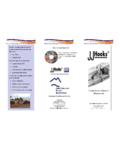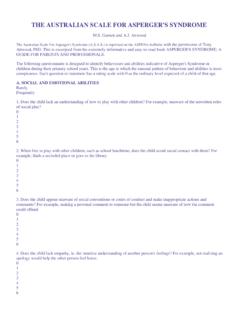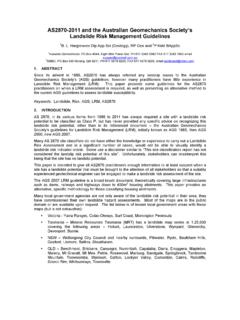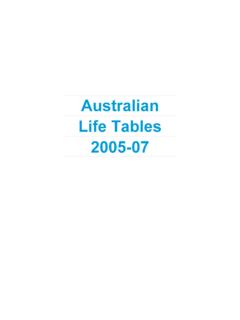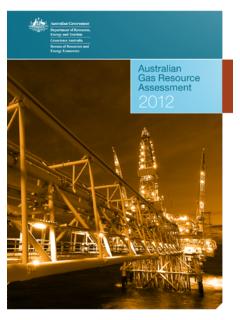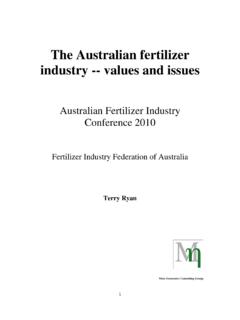Transcription of from AUSTRALIAN ROAD BARRIERS
1 INSTALLATION & MAINTENANCE. INSTRUCTIONS.. Concrete Safety BARRIERS from AUSTRALIAN . road BARRIERS . Under License from the Trademark Proprietor, Easi-Set Industries, Midland, Virginia, USA. AUSTRALIAN road BARRIERS PTY LTD. RMB H535, BALLARAT, VIC 3352. ABN 91 121 470 102. Freecall: 1800 003 826 Fax: 03 5339 9273 Email: Revision History Revision Amendments Authorised Initial Release. April 2006 1. QLD Department of Main Roads approval letter added. 2. Miscellaneous minor corrections. August 2006 1. SA Department of Transport, Energy and Infrastructure approval letter added. 2. Section Estimated Deflections July 2008 1. Major Revision. 2. Layout and Format Changes. 3. Information added regarding lifting and slinging, installation procedure and delineation requirements.
2 April 2009 1. Section Site Conditions J Govan 2. Section Delineation 3. Important Notes IMPORTANT NOTES. 1. This manual must be read in conjunction with the road Authorities guidelines, the site specific risk assessment and the traffic management plan for the worksite. 2. The road authorities in each state reserve the right to approve, reject or restrict the use of specific products within the road reserve. If you are unsure of the current status of any products within this manual please contact AUSTRALIAN road BARRIERS on 1800 003 826. 3. J-J Hooks Safety BARRIERS are not warranted to prevent any injury or loss due to any accident howsoever caused but may significantly reduce the consequences of such an accident. 4. It is the responsibility of the end user to assess the risks associated with the use of (or the failure to use) a safety barrier system tested in accordance with the NCHRP Report 350 test methods, and with the particular site and traffic conditions for which BARRIERS are being considered.
3 TABLE OF CONTENTS. IMPORTANT NOTES II. 1. INTRODUCTION 1. 2. DESIGN . 2. SITE CONDITIONS 2. SITE GEOMETRY 3. WORKING WIDTH 3. ATMOSPHERIC CONDITIONS 3. EMERGENCY ACCESS 3. MINIMUM LENGTH 4. TERMINATING THE SAFETY BARRIER 4. DELINEATION 4. 3. INSTALLATION 5. RESOURCES REQUIRED 5. LIFTING PROCEDURE 5. Pre Lift Inspection 5. Sling Angle 6. Lifting 6. INSTALLATION SEQUENCE 7. INSTALLATION PROCEDURE 7. SITE SCREENS 8. MAINTENANCE 8. INCIDENT REPORTING 8. 4. COMPLIANCE ISSUES 9. CRASH TEST 9. AUSTRALIAN STANDARDS 9. ESTIMATED DEFLECTIONS 10. APPENDIX 1. OPTIONAL END TREATMENTS 11. APPENDIX 2. WORKSAFE / VICROADS SAFETY BARRIER CHECKLIST 13. APPENDIX 3. road AUTHORITY APPROVALS 16. -1- 1. INTRODUCTION. The purpose of this document is to provide the end user of J-J Hooks.
4 Safety Barrier Systems with installation and maintenance instructions to enable the BARRIERS to be used safely and in accordance with the AUSTRALIAN and New Zealand Standard AS/NZS 3845:1999 road Safety Barrier Systems, and with the requirements of the local road authority. The J-J Hooks Concrete Safety Barrier from AUSTRALIAN road BARRIERS Pty Ltd is a precast reinforced concrete barrier incorporating the patented J-J. Hooks connection system. The BARRIERS when placed on site form a continuous chain of positively interlocked safety BARRIERS capable of accommodating varying horizontal and vertical alignments. The J-J Hooks Safety Barrier system has been tested to Test Level 3 (TL- 3) of the United States National Cooperative Highway Research Program (NCHRP) Report 350 and complies with the manufacturer's requirements of AS/NZS 3845.
5 It is recognised that in many instances where a safety barrier system is being considered, full TL-3 compliance may not be warranted. Examples include worksites where the traffic speeds are significantly less than 100. kph or where the possible angle of a crashing vehicle to the barrier is significantly less than 25 . For this reason the use of J-J Hooks BARRIERS in configurations other than those replicating the test configuration are not precluded by these instructions provided an appropriate hazard assessment has been performed by the end user. Revised July 2008. 2. DESIGN . Prior to the installation of any safety barrier system the end user should give consideration to a range of items, including, but not limited to: Site conditions, geometry and working width.
6 The length of barrier to be installed and the safe termination of the system;. Site access requirements, including emergency access;. Any requirements for site screens, delineation, signage, etc.; and The results of any Risk Assessments undertaken for the project. VicRoads and WorkSafe Victoria have jointly developed a checklist for temporary safety BARRIERS , titled Roadside Worksite Traffic Management Checklist Temporary Safety BARRIERS ' (refer Appendix B). While the checklist is primarily designed for use as an on-site inspection tool, AUSTRALIAN road BARRIERS recommends that reference to the document is made at the design stage. Site Conditions J-J Hooks BARRIERS must be placed on a flat, stable and compacted surface capable of being trafficked by road vehicles for short periods.
7 The crossfall must not exceed 6%. Unstable surfaces such as deep mud, uncompacted sand or excessively wet surfaces are considered inappropriate. Ideally the surface should be paved and must be free of swales, ditches or other irregularities. The minimum width of stable ground behind the BARRIERS must not be less than the expected deflection of the barrier system (refer below). BARRIERS must be placed at the same level as the travelled lane and must not be placed in front, behind or on top of kerbing. -3- Site Geometry BARRIERS should (where practicable) be placed parallel to the travelled lane and as far away from the travelled lane as possible. J-J Hooks BARRIERS are capable of a horizontal curvature of approx. 30. metres radius (left or right), and a vertical curvature of 30 metres radius in sag and 53 metres on a crest.
8 BARRIERS should be placed at the same level as the travelled lane and should not be placed in front, behind or on top of kerbing. Working Width The minimum working width required for the J-J Hooks BARRIERS is the total of the width of the base of the barrier (being 606mm) plus the expected maximum deflection (refer below) and the required offset from the edge of the traffic lane. Working Width Not to Scale Based on Figure 13 . 606 mm Safety Barrier Clearance from the Victorian Worksite Offset Safety Traffic Management from Expected Code of Practice. Traffic Maximum Lane Deflection 810 mm TRAFFIC. Work Zone Edge of Traffic Lane Atmospheric Conditions J-J Hooks BARRIERS are suitable for use in all atmospheric conditions normally encountered on AUSTRALIAN roads without any reduction in effectiveness.
9 Emergency Access Emergency access through J-J Hooks BARRIERS can be achieved by simply lifting the appropriate number of BARRIERS vertically from the line and placing them to one side behind the remaining BARRIERS . If the emergency opening is to be left open, appropriate measures must be taken to treat the exposed ends of the BARRIERS . Revised July 2008. Minimum Length Given an appropriate hazard assessment, J-J Hooks BARRIERS can be installed in any length. In order to replicate the TL-3 test conditions a minimum of metres of barrier should be laid upstream and downstream of the point at which the test deflection is to be achieved. Note: some of the State road Authorities specify a minimum installation length which may be greater than that recommended above.
10 Terminating the Safety Barrier The ends of safety BARRIERS must be appropriately treated to avoid creating additional hazards. A separate end treatment is not required if the line of the BARRIERS can be flared so that the exposed end is located outside the clear zone for the particular site. The width of the clear zone shall be as recommended by the local road authority and is dependant on the traffic speed and (sometimes). on the traffic volume. The flare rate should be not steeper than 10 to 1. Each type of end treatment has its own advantages and disadvantages and in some circumstances, new hazards may be created through their use. It is the responsibility of the user to assess the suitability of any end treatment to the site conditions. End treatments recommended by AUSTRALIAN road BARRIERS are described in Appendix 1.
